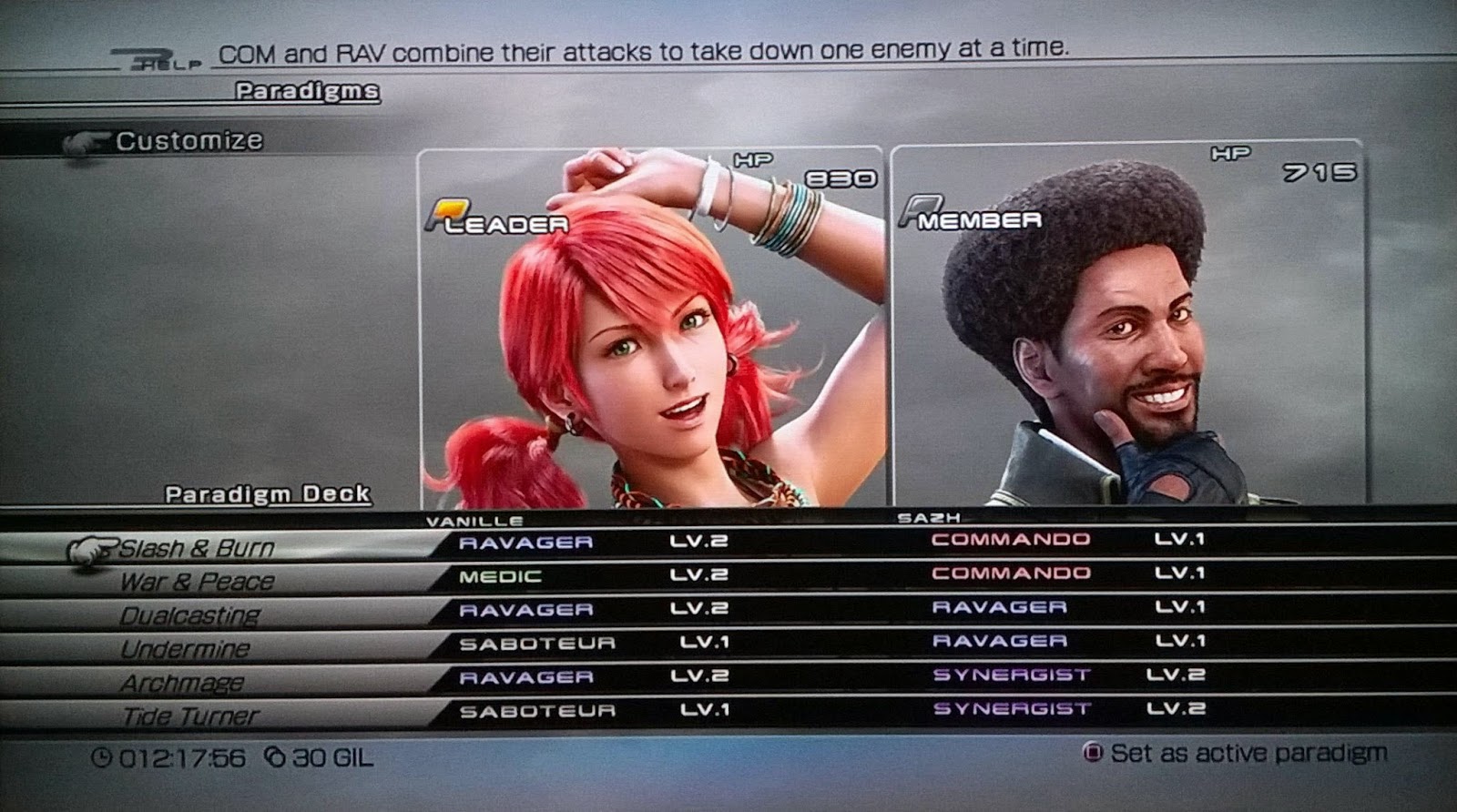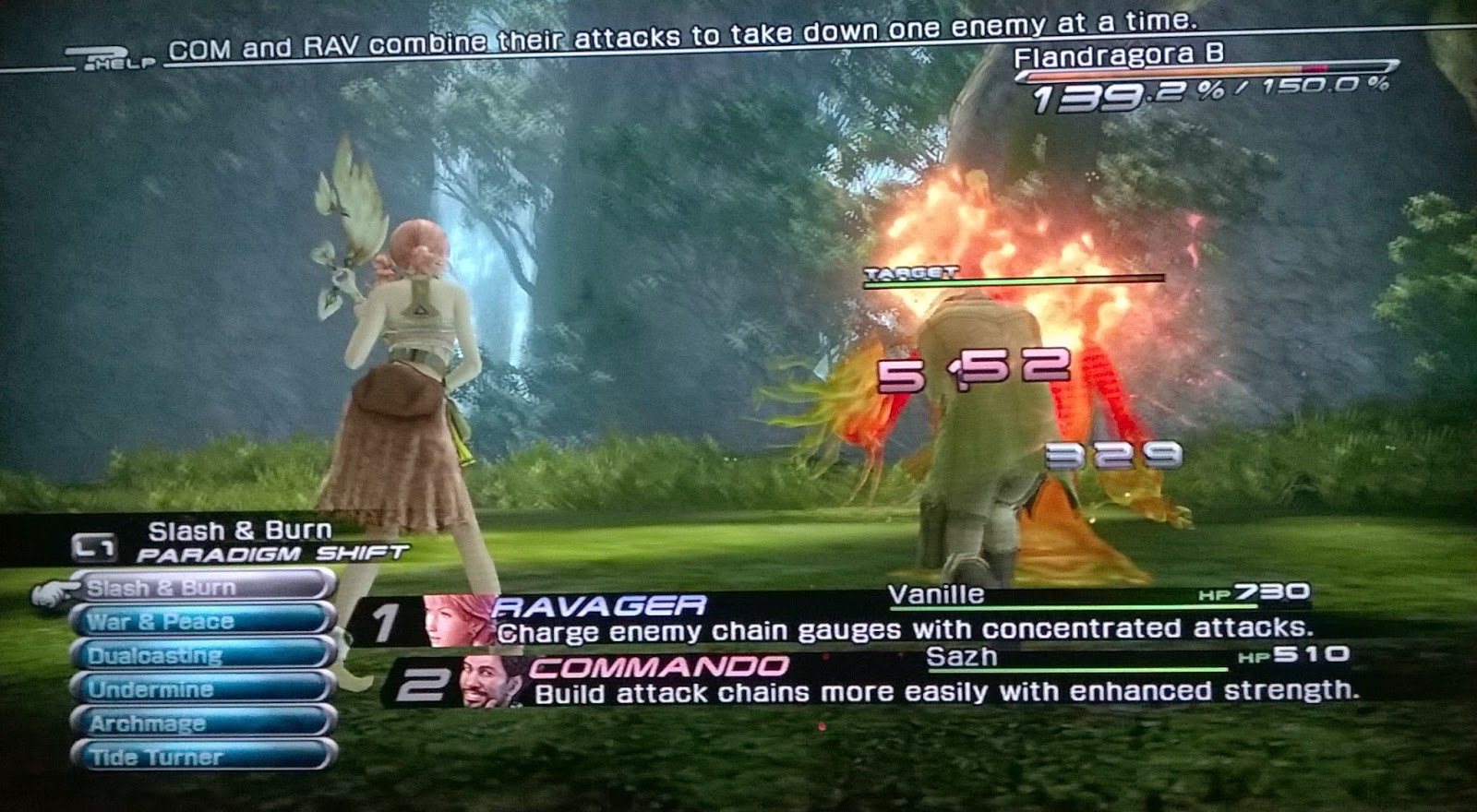Back on Cocoon, our heroes decided to confront the Pulse Fal'Cie, that creature whose presence was responsible for The Purge. Confronting such a powerful being may not have shown great judgment, however, they defeated the massive being, Anima. In it's death throes, it wrapped them in powerful restraints, then branded them... as l'Cie. Conventional wisdom says they are now enemies of Cocoon, destined to seek its destruction. However, the heroes themselves know not what their task is.
Since I mostly covered the characters in my last post, I'll start by summarizing the plot a bit here. Final Fantasy 13 has a pretty deep history and "mythology" as the developers have called it. The people on Cocoon are overseen by massive, powerful beings called Fal'Cie. Many people talking about the game refer to them as gods, but I don't think that is most appropriate, as altough the Fal'Cie are much more powerful than humans, they do not approach the power of gods. There are thousands, possibly millions of Fal'Cie, some of which have such mundane tasks as being a "bulkhead", up to being the source of Cocoon's light (Phoenix), and creating the human's food (Carbuncle).
 |
| A bulkhead Fal'Cie, which serves as a massive... bulkhead. |
Besides managing the human's lives, the Fal'Cie have an important power, to turn a human into a l'Cie. L'Cie are branded and given a task called a focus. However, this focus is only vaguely given, through a vision as the l'Cie is branded. L'Cie also gain certain powers, such as access to magic. If a l'Cie does not complete it's focus withing a certain amount of time, they become creatures called Cieth. Cieth are creepy beings that are essentially monsters.
 |
| This tormented Cieth is choking itself. Perhaps it's into auto-erotic asphyxiation. |
Beneath Cocoon is the planet Pulse, which the people of Cocoon live in dire fear of. Pulse also has Fal'Cie, who are able to create their own l'Cie. This is a large part of the premise of FF13, as early in the game the main characters find a Pulse Fal'Cie. The discovery of this Fal'Cie has caused "The Purge". The characters end up meeting at the Pulse Fal'Cie, Anima. They fight and defeat it, however the Fal'Cie brands all of them as l'Cie.
 |
| Battling Anima. |
The "vestige" which is the huge structure that contains the Fal'Cie falls into Lake Bresha, and in its death throes it turns the lake to crystal, shown in the last post. Beyond that, the characters than try to figure out how to handle their situation, as as far as they have been taught, as Pulse l'Cie, they are enemies of Cocoon.
 |
| There are numerous flashback scenes in FF13. This one shows the Pulse Vestige in the distance. |
There's a lot of detail and character development that happens after that, but that gets you relatively up to date on the story. On to some game mechanics. Combat is mostly automated, which some people appreciate, but I personally find kind of dull. On the surface it can appear very simple since the player doesn't have to make many selections, but underneath this the mechanics of the combat system are actually very complex. I find that this means there isn't as much opportunity for mastery by the player, and thus find it a little less satisfying than most Final Fantasy combat systems.
The characters have "roles" which are similar to classes or jobs from other systems. The characters don't access these roles until they gain their l'Cie powers, and this is when the combat system starts to flesh itself out. The roles are Commando, Ravager, Sentinel, Medic, Synergist, and Saboteur. These roles encompass the abilities of previous games, but simplified down to their core. Commando's attack, doing the most damage. Ravagers cast magic, but their role in this game is building "chain bonuses". Sentinels are defenders, drawing attacks. Medics are "white mages", or healers. Synergists buff your members, Saboteurs de-buff your foes. Together, these groups of roles are called "Paradigms".
 |
| Viewing available paradigms. |
 |
| Shifting paradigms in battle. |
The complexity of the system comes into play when you consider that a key to combat is building "chains". This is an expansion on the system from FF10-2. When you strike an enemy it builds their chain gauge, which is displayed in the upper right corner of the screen above. When it's filled the enemy is "staggered", and takes more damage. Staggering enemies is essential to success in the game. I don't know about you, but even describing this seems unnecessarily complicated and somewhat uninteresting, which makes it no surprise that is how I feel about the system while playing! Am I being too harsh? I'm not sure, the combat system seems to have been relatively well received at large, but I find it of average appeal. I should say it's alright during regular, fast combats, but often when you run into harder foes it becomes a trial and error system which is aggravating, I very much dislike "trial and error" gameplay. The Eidolon battles are the worst, but I'll cover that later.
 |
| The gameplay images were getting a bit boring, so here is Vanille in front of a tomato bush. You say tomato, I say... tomato. |
Strangely, the game incorporates arcade elements with the combats, giving you a summary of the time it took, and even a score. After reading some statements from the director of the game, I understand they were almost trying to create a new genre, an interactive action third person arcade shooter movie or something... so... I guess this score thing makes more sense. On a side note, I think I had a bit of a revalation while playing that maybe this game really isn't an RPG! I plan to apply CRPG addict's definitions of an RPG and see how well the game does, haha. I digress, but I think this helps to explain the games reception, as it departs a little too much from the assumptions of its franchise.
 |
| The after combat summary screen. Higher ratings increase your chances of getting better item drops. |
Outside of combat, the big time departures from series conventions continue. There are no "towns" per se, there are very few NPCs you can actually speak with, most talking is displayed automatically as you walk by a character. Shopping is handled "online", at kiosks that also allow saving. The shops are kind of neat and have their own personalities, but I miss the towns. Once an item becomes available you can buy it at any kiosk. I've found the new items are generally things that have already appeared in treasure, so there isn't that motivation to grind for a new item in a shop like is generally present in RPGs.
I'm not going to lie, I'm getting bored writing this post. Which makes me ask whether it's just boring to write about, or whether this game is actually... f'in boring! I'm curious what readers think. To tie up the mechanics is the character development which is handled by the "crystarium", because in Final Fantasy, and I think Japanese games in general, every new little development needs a creative new name, and if it has an acronym, even better (see ATB, CTB, RTB, ADB and CSB). The crystarium can be thought of as a simpler version of the sphere grid from FF10. The characters have a few choices of paths, but cannot branch into other character's paths like on the sphere grid. Also, the crystarium is limited by where you are in the storyline, so power-leveling is not possible. Overall, it probably won't surprise you I find the crystarium pretty average, as there is no motivation to grind, and I don't think there are meaningful choices to be made in character development, making the game seem even more like a railroad.
 |
| The crystarium. |
That sums up the core of the game mechanics. You may remember I decided to play FF13 after FF10 to see if I have gained some new perspective on it, perhaps being able to forgive it for its linearity. However, there is no doubt I dislike this game even more this time around. FF10 did have very linear dungeons. However, the random encounters actually helped that game out, making the areas seem more full, FF13's dungeons end up being massive empty rooms and tubes. FF10 also had towns and the puzzles of the temples to break up gameplay that might have become monotonous. FF13 breaks up combat with one thing and one thing only... cutscenes... over and over again. Cutscenes used to be a reward in Final Fantasy games, coming rarely and at key climaxes. In FF13 they happen so often you wish you could just play the damn game for once! Granted, you can skip cutscenes, but I don't find that to be a good defense for their overabundance, because you won't know what's happening if you do. That's all I've got for this week. FF13 still has some time to redeem itself, but so far it's not doing too hot.
As l'Cie, the heroes have gained great power, but are now fugitives. To find out how they fare as foes against all they have known and held dear, come back soon... for This Bard's Tales!
Play Time to Post: 6h 43m
Total Play Time: 16h 7m

No comments:
Post a Comment